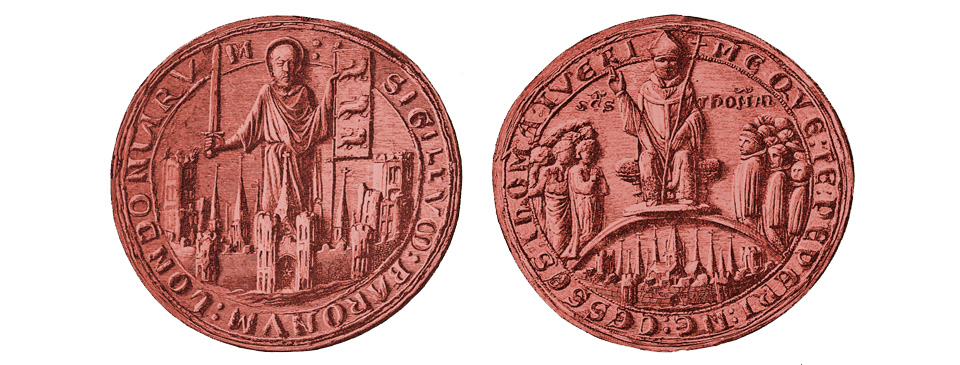In Brief – London in the early-Middle Ages

The early 13th century seal of the City of London. On the right is Thomas á Becket and on the left St. Paul defending London.
During the 12th century the population of London doubled in size to around thirty thousand. By the Middle Ages the city had enjoyed a long period of relative peace, with trade bringing prosperity. Many of the growing population were merchants who had come from around the country (possibly arriving as young apprentices) or as far away as the Continent. Grand houses were located throughout the city but were often surrounded by poorer housing and workshops.
The royal court and the legal profession, which had previously travelled together between various parts of the kings’ lands, became more permanently fixed at Westminster. Barons and leading clergy were obliged to regularly attend court and needed places where they and their courtiers and servants could reside. Large houses or palaces began to appear facing the Thames along Fleet Street and the Strand.
The old Roman wall, already a thousand years old, continued to protect London and define its boundaries on the landward sides, although the riverside length had disappeared in earlier centuries. In addition to the original Roman gates, the small entrance-way that provided a walkway through the wall to the north was enlarged into Moorgate following the drainage of Moorfields after 1415. Cripplegate was rebuilt in 1491 with money left in the will of a goldsmith. The gates at Newgate and Ludgate acted as prisons.
Many city street names seem to have come into existence in the 12th and 13th centuries. Those engaged in individual types of trade often lived and worked within the same district of the city and a number of streets in the modern City, such as Wood Street, Bread Street, Milk Street and Poultry still reflect those businesses. ‘Cheap’ is an old word for market and survives in the modern street name Cheapside. Jews lived in a small district of several streets, one of which remains as Old Jewry. Most shop-keepers, artisans and workers of the early Middle Ages lived in very similar conditions to their Saxon predecessors of three hundred years earlier. Their houses were very small, mostly with living quarters above a shop or workshop, constructed of wood, with a thatch roof.
The most important official in early medieval towns and shires, as it had evolved since the reign of King Aethelred in the 10th century, was the sheriff – the reeve of the shire – who, as the monarch’s representative, was answerable directly to the Royal Exchequer. It was, amongst other duties, the responsibility of the sheriffs of London and Middlesex to collect money owed to the Crown by citizens and every six months deliver it to Westminster.
From the re-founding of London during the Saxon period a system of government evolved based on small areas of wards and parishes. By the mid-13th century twenty four ward boundaries had been established, each headed by an ‘alderman’. They met regularly at the Guildhall in order to co-ordinate civic management and discuss important political matters such as issues with the Crown. Over time the collective group became known as The Court of Aldermen, the governing body for the City of London.


